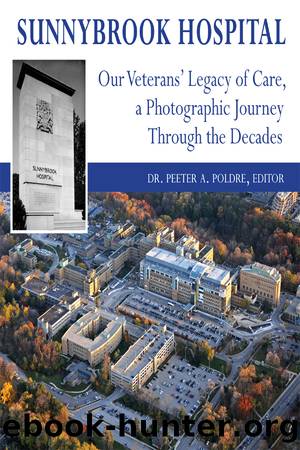Sunnybrook Hospital by Peeter A. Poldre

Author:Peeter A. Poldre
Language: eng
Format: epub
Publisher: Dundurn Press
Sunnybrook Hospital becomes Sunnybrook Medical Centre (1973).
Dr. Kirk Weber, Chief of Anaesthesia (1972â92).
Dr. Alan W. Harrison, Chief of Surgery (1966â67 and 1969â85).
Dr. Bob McMurtry, Chief of Emergency Services (1975â87).
After years of advocacy by individuals such as Dr. Marvin Tile, the Regional Trauma Unit was opened in July 1975. Its first director was Dr. Bob McMurtry. Other key clinical leaders included Dr. Glen Taylor (shock and thoracic injury management), Dr. Michael Schwartz (head injuries), and Dr. Jim Powell (multiple fractures management). Leaders in the care of abdominal injuries included Dr. H.A.B. (âBeansâ) Miller, Dr. Sherif Hanna, and Dr. Alan Harrison. The Sunnybrook Trauma Program had many associated innovations, such as the âone number to call,â based at Sunnybrook, Bandage One helicopter, a program to educate youth about trauma risks (the PARTY Program), and the involvement of Sunnybrook physicians as the base hospital for paramedics. Dr. Tileâs clinical expertise, research, and education in the management of pelvic fractures garnered international recognition.
The second half of the 1970s saw the building of the Kilgour Wing (1976), named in honour of the Kilgour family, as a new residence for the veterans at Sunnybrook. The Hees Wing, named in honour of the Honourable George Hees, Minister of Veterans Affairs, opened in 1990 to provide more residential space for veterans.
In the early 1970s, with the radiation therapy resources of the Princess Margaret Hospital (PMH) reaching capacity, a commission was established to recommend a second site in Toronto for comprehensive cancer care. Sunnybrook was ultimately chosen as the site, largely because of the desire to have a strong research presence in the proposed new centre. Dr. Ray Bush and Dr. Donald Cowan, then at PMH, as well as Dr. K.G.R. Wightman, head of the Ontario Cancer Treatment and Research Foundation, led the planning initiative, which started in earnest in 1974. In the planning stage, the site was named the North Toronto Cancer Centre. The opening of the renamed Toronto-Bayview Regional Cancer Centre, on the site of what had been the Red Cross Lodge, occurred in 1981. Early leadership during this era was provided by Dr. Derek Jenkin (Radiation Oncology) and Dr. David Osoba (Medical Oncology), both of whom were recruited from PMH. Dr. Hugh Barber (Otolaryngology) was an influential force in fostering research opportunities for the new cancer centre as well as for the rest of the hospital. Dr. Ralph Gilbert (Otolaryngology) was appointed to the newly created and at the time unique position of Director, Surgical Oncology.
Download
This site does not store any files on its server. We only index and link to content provided by other sites. Please contact the content providers to delete copyright contents if any and email us, we'll remove relevant links or contents immediately.
What's Done in Darkness by Kayla Perrin(25493)
Shot Through the Heart: DI Grace Fisher 2 by Isabelle Grey(18209)
Shot Through the Heart by Mercy Celeste(18153)
The Fifty Shades Trilogy & Grey by E L James(17768)
The 3rd Cycle of the Betrayed Series Collection: Extremely Controversial Historical Thrillers (Betrayed Series Boxed set) by McCray Carolyn(13182)
The Subtle Art of Not Giving a F*ck by Mark Manson(12898)
Scorched Earth by Nick Kyme(11823)
Stepbrother Stories 2 - 21 Taboo Story Collection (Brother Sister Stepbrother Stepsister Taboo Pseudo Incest Family Virgin Creampie Pregnant Forced Pregnancy Breeding) by Roxi Harding(11019)
Drei Generationen auf dem Jakobsweg by Stein Pia(10211)
Suna by Ziefle Pia(10180)
Scythe by Neal Shusterman(9251)
International Relations from the Global South; Worlds of Difference; First Edition by Arlene B. Tickner & Karen Smith(8600)
Successful Proposal Strategies for Small Businesses: Using Knowledge Management ot Win Govenment, Private Sector, and International Contracts 3rd Edition by Robert Frey(8407)
This is Going to Hurt by Adam Kay(7682)
Dirty Filthy Fix: A Fixed Trilogy Novella by Laurelin Paige(6445)
He Loves Me...KNOT by RC Boldt(5798)
How to Make Love to a Negro Without Getting Tired by Dany LaFerrière(5369)
Interdimensional Brothel by F4U(5299)
Thankful For Her by Alexa Riley(5149)
